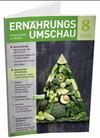Insects as food: perception and acceptance
IF 0.3
4区 医学
Q4 NUTRITION & DIETETICS
引用次数: 73
Abstract
The production of animal protein is linked to high resource consumption, requiring a lot of agricultural land, water and energy. Traditional livestock farming and meat production are also morally questionable. Interest in alternative protein sources which can be produced using fewer resources has rapidly increased in recent years. Due to a report by the FAO [1] and the commitment of individual scientists, public interest in insects as an alternative protein source has increased. Insects can be a source of high-quality protein (i.e. source of essential amino acids, vitamins and minerals) depending on the species, stage of development and diet [2]. In comparison to some meat products they also have lower concentrations of cholesterol alongside a favorable n-3/n-6-fatty acid ratio [3–5]. Another advantage of insects is that their production is comparatively environmentally-friendly. A recently published comparison of the environmental impact of different meat alternatives demonstrated that insect and soya flour based alternatives have the lowest environmental impact, that milk and gluten-based alternatives have a moderate impact and that cultured meat or myco-, i.e. mushroom based, analogues (e.g. QuornTM) have the highest impact [6]. Approx. 2,000 species of edible insects have been identified globally to date [7]. In many cultural spheres, e.g. in East Asia, Africa and South America, they are harvested from the wild and are part of the traditional diet [1]. In contrast, in Western countries they tend to trigger disgust rather than a desire to eat. The present article gives an overview of the current data available on the subject of the perception and acceptance of insects as food from a consumer perspective. Abstract昆虫作为食物:感知和接受
动物蛋白的生产与高资源消耗有关,需要大量的农业用地、水和能源。传统的畜牧业和肉类生产在道德上也存在问题。近年来,人们对可以使用较少资源生产的替代蛋白质来源的兴趣迅速增加。由于粮农组织的一份报告[1]和个别科学家的承诺,公众对昆虫作为替代蛋白质来源的兴趣有所增加。昆虫可以是高质量蛋白质的来源(即必需氨基酸、维生素和矿物质的来源),这取决于物种、发育阶段和饮食[2]。与一些肉制品相比,它们还具有较低的胆固醇浓度以及有利的n-3/n-6脂肪酸比例[3-5]。昆虫的另一个优点是它们的生产相对环保。最近发表的一项关于不同肉类替代品对环境影响的比较表明,以昆虫和豆粉为基础的替代品对环境的影响最小,以牛奶和麸质为基础的替代品对环境的影响中等,而以培养肉或真菌为基础的类似物(如QuornTM)的影响最大[6]。迄今为止,全球已确定的食用昆虫约有2000种[7]。在许多文化领域,例如在东亚、非洲和南美洲,它们是从野外收获的,是传统饮食的一部分[1]。相比之下,在西方国家,他们往往会引起厌恶而不是想吃东西。本文概述了从消费者角度对昆虫作为食物的认知和接受这一主题的现有数据。摘要
本文章由计算机程序翻译,如有差异,请以英文原文为准。
求助全文
约1分钟内获得全文
求助全文
来源期刊

Ernahrungs Umschau
医学-营养学
CiteScore
0.50
自引率
40.00%
发文量
0
审稿时长
>12 weeks
期刊介绍:
The ERNÄHRUNGS UMSCHAU publishes reviews and original articles on the whole area of nutrition science, including nutrition behavior, nutrition economics, public health nutrition, nutritional medicine and other areas of importance for human nutrition.
 求助内容:
求助内容: 应助结果提醒方式:
应助结果提醒方式:


